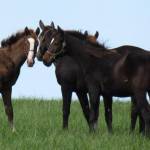Horse Industry Study: Racing Success

Every spring, horse farm pastures display a new crop of Thoroughbred foals. Most of the frisky, long-legged youngsters have been produced with the goal of winning races, but how many will actually make it to the starting gate in the next few years? Numbers from one study conducted in the U.K. indicate that as few as half of an average year’s foal crop will eventually be seen at the racetrack, and fewer than that will ever enter the winner’s circle.
Researchers at the University of Cambridge collected information on 1,022 Thoroughbred foals from birth to three years of age. Of that number, 289 of the horses were exported, and there is no record of whether these horses raced in a different location. Another 562 entered race training in England or Ireland, 537 as two-year-olds and 25 as three-year-olds. From the group that began training at two years of age, 327 competed at least once; there were 260 first-place or second-place finishes in at least one race; and 28 horses (5%) earned enough money to cover training fees.
In the next racing year, 80% of the horses that had entered training as two-year-olds were still in training, and all 25 horses that were held until turning three also entered training. From this group of 456 three-year-old horses, more than three-quarters raced at least once; there were 356 first-place or second-place finishes in at least one race; and 78 (17%) won enough money to pay for training costs.
The most common health problems for horses in training as two-year-olds were sore shins, inflammatory airway disease, and joint problems. For three-year-olds, the most common problems were sore shins, joint problems, and fractures. Sore shins affected more colts than fillies in both years. Incidence of inflammatory airway disease was similar for colts and fillies in both years. Joint problems were similar in two-year-olds but were twice as prevalent in colts as in fillies at the age of three. A slightly smaller percentage of horses suffered fractures at three than at two. Twice as many colts as fillies suffered fractures as two-year-olds; that ratio was reversed in three-year-old horses. Overall, fillies had a higher rate of tying-up, while colts had a larger percentage of musculoskeletal problems during training.
Racing success is a result of many things including heredity, trainer, jockey, conditioning program, nutrition, weather, track surface characteristics, farrier care, and other factors. Bone tends to adapt slowly to the demands of racing, and some skeletal problems can be avoided by gradually increasing exercise level, being aware of the first signs of heat or swelling, and temporarily backing off on work if even mild lameness is detected.
Use of a nutritional supplement in young horses can sometimes help in supporting skeletal development. Developed by Kentucky Equine Research (KER), DuraPlex is a proprietary blend of specific proteins, minerals, and vitamins clinically proven to increase bone mineral density and bone area in growing horses. DuraPlex was also shown to prevent the natural demineralization that occurs when access to free-choice exercise is restricted such as when young horses enter a training environment or during stall rest due to injury. Racehorse trainers in Australia can ask for a similar product, Bone Food.
Inflammatory airway disease might be offset by the immune-boosting effects of omega-3 fatty acids, such as DHA and EPA found in EO•3, also developed by KER. EO•3 is made from fish oil, a direct source of EPA and DHA, which are the most useful omega-3 fatty acids for conferring health benefits.








